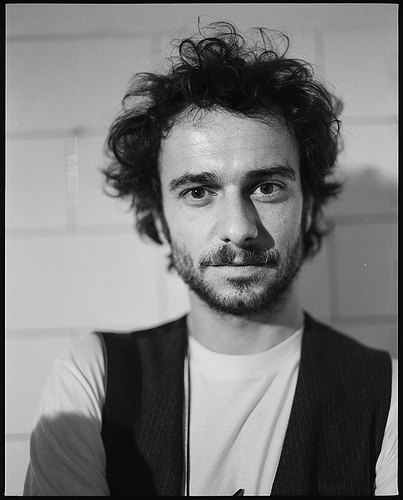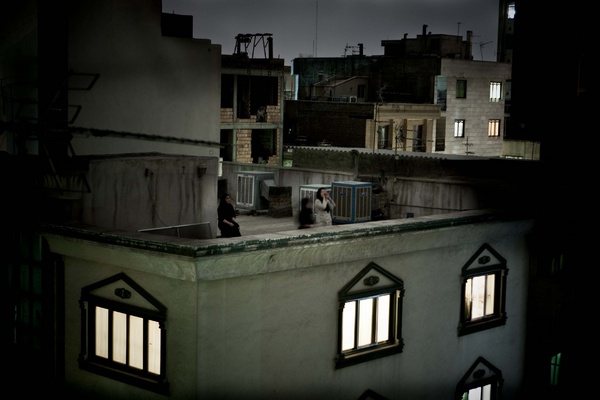 Pietro Masturzo is the author of the best photograph of 2009, according to the jury of World Press Photo. He is also a 30-year-old freelance photojournalist from Naples, who managed, with his singular way of capturing reality, to show us what was happening on the rooftops of Teheran in the summer of 2009. Almost two years have passed since the troubled presidential elections in Iran when Mahmoud Ahmadinejad was voted in for a second term, despite the protests of the Iranian population.
Pietro Masturzo is the author of the best photograph of 2009, according to the jury of World Press Photo. He is also a 30-year-old freelance photojournalist from Naples, who managed, with his singular way of capturing reality, to show us what was happening on the rooftops of Teheran in the summer of 2009. Almost two years have passed since the troubled presidential elections in Iran when Mahmoud Ahmadinejad was voted in for a second term, despite the protests of the Iranian population.
In this interview, to which Pietro Masturzo replied by email from Yangon (Myanmar), the photographer tells of his experience of those events. Masturzo also talks about photojournalism and how difficult it is for some projects to find a place in a media system that prefers on-the-spot action to taking time out for reflection.
Pietro Mastruzo, portrait by Sasha Krasnov
What made you decide to go to Teheran on your own account?
Iran had been on my agenda for a long time. It had already aroused my interest during my university years. The long awaited presidential elections and the thirtieth anniversary of the Islamic revolution made me think that June of 2009 could be the best time to visit.
The decision to go to Teheran on my own account was really a personal obligation: today it is not easy for freelance correspondents to enter.
Some journalists say that it was very difficult to cover the events. What was the atmosphere like? What was it like for you?
Iran, according to Reporters without Borders, is among the top ten countries in which it is most difficult for journalists to work. It certainly deserves to be among the “top ten”.
The atmosphere was already tense in the days leading up to the elections. Afterwards, it became even more complicated.

“From the roofs of Teheran”, World Press Photo del año 2009 – Pietro Masturzo
How did you take the photo?
As I already said, taking photos in the streets, and for someone only equipped only with a tourist visa, was not at all easy. I managed to get a few photos out of the country thanks to the help of some Iranians, mainly students.
Why did you photograph the roofs?
I had the impression that a special history was taking place on every roof. They were all looking to the past, the present and the future at the same time. I was fascinated by the idea of my photos documenting such a broad and dramatic time.
There are women in the photograph. What were Iranian women doing during the protests?
The women participated actively both in the protests in the square as well as those on the roofs.
The revolution on the roofs consisted in continuous chanting: Allah u Akbar, Allah is great. The calls were made insistently by women and men such as during the times of the Revolution against the Shah. It appeared to me that the women, who suffer discrimination under the Iranian Sharia law, were reconquering total equality with their protest.
The World Press Photo Award is a prize that has historically been won by photojournalists from well-known agencies. You were working freelance, and your picture hadn’t been published in the media. What made you enter it in the contest?
The World Press Photo is a prize open to all professional photographers. The fact that for the first time it has been awarded to a freelance photographer was also a pleasant surprise for me. This demonstrates that the jury only took into account the photos and not the labels attached.
My work had not been used much in the media for two reasons. The first is due to current publishing trends. When I returned from Iran, two weeks has passed since the elections and the events in Tehran were no longer dominating the front pages of the newspapers, because nowadays the media is only interested in the “obsession for live news”, and very little space is reserved for reflection and in depth study. Apart from this, I should point out that my photos tend not to be very graphic and so do not fit into the more direct communicative style that seems to be more popular today.
Have you been back to Iran since the elections? What do you think the situation is like in Iran now? Did those citizen protests serve any purpose?
Unfortunately, it is not possible for me to get into Iran so easily, but I still try to receive news thanks to my contacts.
A certain “normality” has, without doubt, returned to the country but the events of 2009, in my opinion, made a deep impression on Iranian society and especially on the inhabitants of the large cities. I consider that Iran is moving towards radical changes, but this process will take a long time. The protests of 2009 were a significant step in this direction.
People say that the Internet and tools like Twitter helped information about the revolt to spread more easily and gave the protests a higher media profile worldwide. Do you think this is the case?
Without doubt, Internet and especially the social networks played a large part in the transmission of the events. Perhaps for the first time the information came almost exclusively from these channels, from the moment in which most of the foreign journalists were not permitted to leave their hotels.
What do you think of “street journalism”? Can a photo taken by someone who doesn’t work in photojournalism have the same value and impact as one taken by a professional?
I think that, with regards professional journalism, “street journalism” like media activism plays a different role in the process of media communication. Their importance in providing information is indisputable and it would be anachronistic to deny their role. However, I do not believe that journalism and its in depth analysis can be substituted so easily. Indeed, a good professional photographer uses knowledge inherent to photographic signals and language, which is a better vehicle for the content. The photographer is, in reality, a narrator.
In a world dominated by big news agencies, how do you think independent journalism projects can emerge and make themselves seen?
I think that independent photojournalism and the small entities such as photographic communities have acquired enormous credibility in recent years and they can make a space for themselves among the big news agencies. Of course, freelance photographers still have many problems which are mostly connected to the precariousness of the profession and the total lack of guarantees. We should work hard in the defence of independent photographers and offer more support to “slow journalism” projects, which are otherwise condemned to extinction.
Has the fact that you won the World Press Photo Award changed your career?
The WPP has provided, without doubt, an optimum opportunity for people to get to know me and my work that otherwise I would never have had. However, the problems that I have mentioned continue to be very important for me.
The World Press Photo 2009 award-winning photos will be on display in the CCCB until the 8th of December 2010. More info








[...] Entrevista a Pietro Masturzo, guanyador de la millor fotografia del 2009 [...]
[...] guanyadora de la mostra del 2010, un exemple clar de periodisme honest i de denúncia. En una entrevista a Pietro Masturzo, el fotoperiodista freelance va declarar que “aquesta era una història que [...]